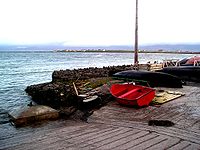Castlegregory
| Castlegregory Irish: Caisleán Ghriaire | |
| County Kerry | |
|---|---|
 Main Street, Castlegregory | |
| Location | |
| Grid reference: | Q617134 |
| Location: | 52°15’20"N, 10°1’16"W |
| Data | |
| Population: | 370 (2022) |
| Local Government | |
Castlegregory is a village in County Kerry. It is situated on the north side of the Dingle Peninsula, halfway between Tralee and Dingle. As of the 2022 census, Castlegregory had a population of 370.
The village is named after a castle built by Gregory Hoare in the 16th century. In Irish it is called Caisleán Ghriaire ("castle of Griaire")[1] Castlegregory is the principal village in Lettragh, the name given to the northern side of the Dingle Peninsula.
Contents
Geography
The village is located at the foot of a sandy peninsula called the Maharees separating Brandon Bay to the west from Tralee Bay on the east. Off the peninsula lie a number of small islands, called the Seven Hoggs, or the Maharee Islands. A small fishing harbour is located at Fahamore on Scraggane Bay, about three miles outside the village at the tip of the Maharees peninsula. The village is surrounded by the mountains of the Dingle Peninsula and overlooked directly by Beenoskee and Stradbally Mountains. To the west is Mount Brandon.
The village is a tourist destination and it is near to a number of beaches located on the Maharees peninsula. Castlegregory Golf and Fishing Club, a nine-hole links golf course, is located to the west of the village on the shores of Lough Gill.
History
On the largest of the Magharee Islands, Illauntannig (Oileán tSeanaigh) are the ruins of a 7th-century monastic site founded by St Senach. On this site there are two oratories, three beehive (or Clochan) huts, and three examples of a leacht (or altar).[2]
Castlegregory was the terminus of a branch line of the Tralee and Dingle Light Railway. The railway station opened on 1 April 1891, and closed for passenger traffic on 17 April 1939. It connected to the main Tralee - Dingle route at Castlegregory Junction (near Camp). While this main route closure stopped passenger traffic, it was to remain open for a once-daily goods train until 1947, after which nothing but a monthly Tralee - Dingle cattle train operated until the main line's final closure in 1953.[3]
Events
Castlegregory Pattern Day was traditionally celebrated on 15 August, when the tradition is to eat locally-made mutton pies. In recent years it has been expanded into a three-day summer festival.[4]
Wren's Day on 26 December is also celebrated. The traditional straw dresses have given way to pyjamas, curtains, Halloween masks, and Christmas decorations, but there is still traditional Irish music to be heard.
Sport
Gaelic games: Castlegregory GAA Club (which was was first known as Castlegregory Allen, named after William Allen, one of three terrorists hanged for an attack in Manchester in 1867)
| ("Wikimedia Commons" has material about Castlegregory) |
References
- ↑ Caisleán Ghriaire / Castlegregory: Placenames Database of Ireland
- ↑ Edward R. Norman (1969). The Early Development of Irish Society: The Evidence of Aerial Photography (Volume 3 of Cambridge Air Surveys). CUP Archive. p. 93.
- ↑ "Castlegregory station". Railscot - Irish Railways. http://www.railscot.co.uk/Ireland/Irish_railways.pdf.
- ↑ "Revived pattern draws crowds to Castlegregory". The Kerryman. 22 August 2012. http://www.independent.ie/regionals/kerryman/localnotes/revived-pattern-draws-crowds-to-castlegregory-27423419.html.
